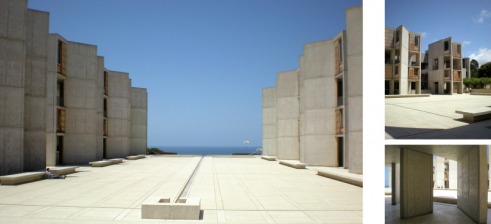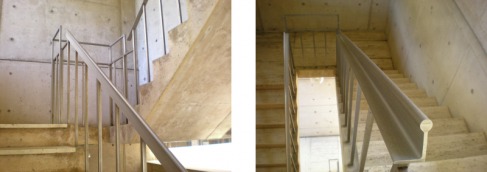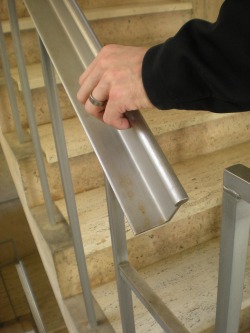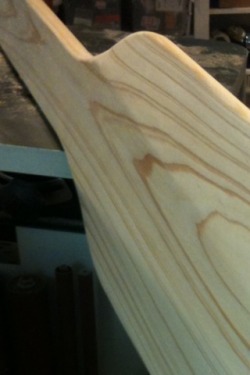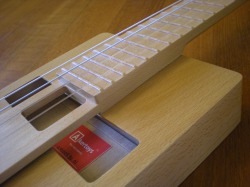[Jennifer] For those of you dying to know the answer to last week's "What's It?"... The photo is a detail of a stairwell at the Salk Institute for Biological Studies in La Jolla, California, designed by architect Louis I. Kahn, constructed from 1960-1966. You might recognize some other views of this project:
In the original
post, Adan's hand is on the handrail/guardrail. The entire rail is fabricated of stainless steel – that's part of why it's looking so great even though it's been exposed to sea air for the past 45-50 years.
(Kudos go to David for noticing a slight amount of rust forming on the steel. Extra points for your optimism that something non-brick could be possible at UVa.) The toprail element is a custom fabrication of extruded stainless steel. If you look closely, you'll see that it's similar to a standard structural shape known as an angle used in many applications in building construction (brick lintels, &c.). My guess is it's an L3x5 modified to have a +/- 1" diameter round bulb flaring from the top flange. It's sized such that your hand fits around the top curve nicely. The shape is strong enough to provide the required structural support for the guardrail, and the custom profile allows it to function as a handrail; it's both in one. It's an elegant move and an excellent example of the economy of means architects and designers struggle to achieve.
This was a custom fabrication job. The shape has a consistent cross-section, meaning it likely was fabricated as an extrusion of stainless steel drawn through a die. Custom extrusions can be prohibitively expensive, but become more achievable if you're making a lot of that custom shape. The design team that developed this detail knew they could use this shape as the handrail on every stair throughout the project. Also, it seems as though they had an amazingly supportive patron and client in Dr. Jonas Salk.
You can learn more about Lou Kahn in the documentary "My Architect," made by his son, Nathaniel Kahn. Nerds can learn more about the technical details in the book Louis I. Kahn: Building Art, Building Science, by Thomas Leslie.
BTW, Adan says "Hi." He misses posting blog updates, but he's busy bringing more power to the electrified baritone ukulele and other fun stuff in development here. Cheers, all.
[Jennifer] Ready to identify some random awesome stuff?
For full credit, I'm looking for the following information about the image above:
- what is Adan's hand resting on?
- what's it made of? Generally speaking, how was it manufactured?
- where is it? (name of building, location and date of completion, name of architect)
Hint: This is not in Tennessee.
Have fun!
[Jennifer] So, a few weeks back we mentioned that AKT HQ has been under siege by squirrels. I think maybe some of you suspect hyperbolation is at work. Please understand, we're not kidding around. This is serious business.
A little back-story may help set this situation in context: Our office is located in a lovely wooded area in East Tennessee. We're surrounded by trees, plants, birds, turtles, etc - it's a fantastic little ecosystem at work. Adan does computer work at his desk in the yellow office next to a window. When we remember, we like to hang up some birdfeed to attract birds, because Adan's into bird watching. Birdfeed attracts birds, birds attract cats, cats attract hilarity.
We're still new to this bird-baiting business, and Adan has observed that different types of suet seemed to attract different types of birds. Recently, he tried a peanut flavored suet in the bird cage. Wow. Not sure what kinds of birds are particularly fond of peanuts, but I know for sure that the squirrels went bananas over this stuff. The suet was like Sirius Black crumbling into a million little ice crystals at the climax of Harry Potter and the Order of the Phoenix. (At least I think that's how that one ended. Who can rememeber that stuff?) Anyway, it was gone in minutes, without a trace. We were left to wonder what happens when one squirrel eats that much food that quickly. And also, we were left with an empty bird cage and no birds.
Almost immediately, the punk squirrel started demanding more peanut crack suet. He climbed all over the tree, shook the empty bird feeder, pointed to it, gesticulated wildly, and generally carried on as you would expect a tiny little addict going into peanut withdrawal to behave. Then he went on the offensive:
Anyone know if squirrels are strong enough to break through 1/8" thick non-tempered glass?
Next: We need to set out some kind of food that would attract an animal that will chase away the squirrels. Suggestions are welcome. Maybe mountain lion bait?
[Adan] Well, as Nancy correctly guessed in the comments, our "What is It Wednesday" challenge image did indeed depict an implement intended for human-powered boat propulsion. In this case the object would most correctly be referred to as a sculling paddle.
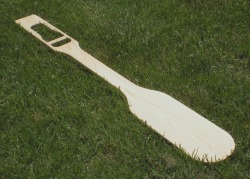
Here's a bigger picture, laid out in the freshly-mown grass.
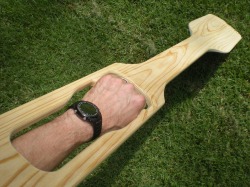
Here's how it's intended to be held.
"Sculling," in the context of paddling rather than rowing, is a cool trick that lets you move continually forward without removing your paddle from the water. You just slice from side to side, in a figure 8 motion (more like ∞ actually), and each time you reverse direction you tip the blade slightly so it's always "climbing."
The customer is a very experienced fisherman (actually has "fishing consultant" on his business card) and came to us with an image in mind of what he wanted. We helped him clarify the image, added dimensions that matched his specific use (from an elevated chair on a fishing boat), and of course I tried to apply a little some of the experience from my years of kayaking :-) We iterated three times to get to this one, which seems to be a pretty fine product. The customer can now maneuver his boat along a riverbank with just his one hand, while he occupies his other hand with the various tasks of fishing.
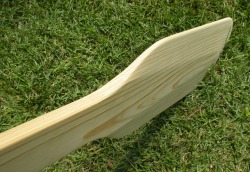
This image shows the blade contours. It took a little wrangling to teach Jobot how to get those nice slicing edges to taper down in a varying angle all the way around the blade perimeter. It turned out pretty great, though. I'm delighted.
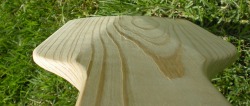
Another image of the blade contours. Pretty huh?
Anyway, hope you like it. We have the customer's permission to reproduce and sell this product (his primary interest for the moment was to have a few for personal use), so if you have a burning need for one (or similar), do feel free to let us know.
And of course, let us know anything at all you feel: comments, hurrah! And, finally, if you'd like, feel free to follow @Akertoys on
Twitter.
[Adan] So I'm thinking it would be fun to post a picture every Wednesday, and ask the world, "what do you think it is??" Maybe someday there'll be a prize given to the correct guesser(s), I dunno, but for now it will just be for the glory. Sound good? Here goes:
Okay, have fun with that. Extra points (whatever those might be) if you can name the wood used for this product, and extra points if you can name the tool on which the product is resting.
This is a Fab Services product, by the way, not something Akertoys sells or plans to sell. If that's helpful as kind of an anti-hint, maybe?
PS: follow us on Twitter, if you'd like: @akertoys
[written by Adan] Today was pretty great, at least the part that’s happened already. It was a complete mixed bag, with forward motion on three different projects. One of these was to glue together two rattle halves and, after allowing adequate glue drying time, rough sand them in preparation for fine sanding, engraving, and hopefully shipping tomorrow.
It’s fun to be working with the rattles. Although our current developmental push is on the musical instruments, people continue to want rattles. We sold six or seven of them in May, and everyone was just so delighted with them. We’re still crazy-slow making them, but we’re learning some tricks.
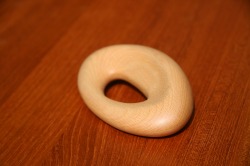
Today’s rattle was made of beech. It’s such a nice wood. I still really enjoy working with it. Here’s a close-up of the one that’s shown in the Etsy listing. With any luck, the bumpy fellow I left in the shop this evening will look just like this tomorrow! Well, like this, but with a cool name engraved on it.
[written by Adan] Ah, the new
bari-uke. I'm so thrilled it's come to fruition. I've been carrying one around for the past couple of weeks and I'm having so much fun with it.
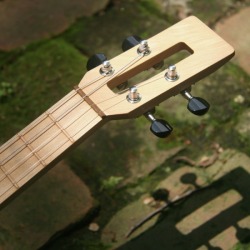
So, what's new? The biggest, most noticeable improvement is the tuners: going from 1:1 friction tuners to these new 8:1 geared tuners makes small tuning adjustments so much nicer. I love it. The tuner change necessitated a headstock tilt, and various other headstock design changes that propagated therefrom, and I'm pretty thrilled about the resulting look. Thanks for your patience with my resistance to change, Jennifer.
We also tweaked the bracing design and undercut a portion of the material that joins the neck to the bridge, freeing up additional soundboard surface to move. You can definitely hear improved balance and lower tones as a result. We evolved our fabrication process too, pretty much every part of it (though there's plenty of room to improve!) The following image shows the undercut, the very uniform fret shaping, as well as another new feature: a makers' label! We now have a company sub-title (Akertoys Fine Instruments) and our products have serial numbers. Not visible at the bottom of the label is a link to this lovely site. We're approaching quasi-legitimacy.
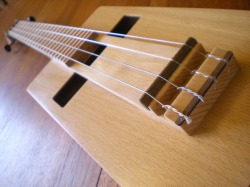
A final pic: bridge/saddle and "tailstock" detail. For this design iteration, we decided all string contact points would be a different material. This improves instrument lifespan (you can tweak and replace the nut and saddle as they wear or your setup preferences change) and helps tone as well, because we chose a very dense wood (ipe, a.k.a. ironwood. The little ipe strip at the end, where the knots are, helps by preventing the strings from cutting into the beech endgrain and of course by making things look just a touch cooler.
Let us know if there are other details you'd like shown in greater detail. Coming soon is a video of the thing in action. Also coming soon: an electrified version. This design is intended to be ready for conversion, it just needs one more cut in the tail and the installation of a pickup and jack.
